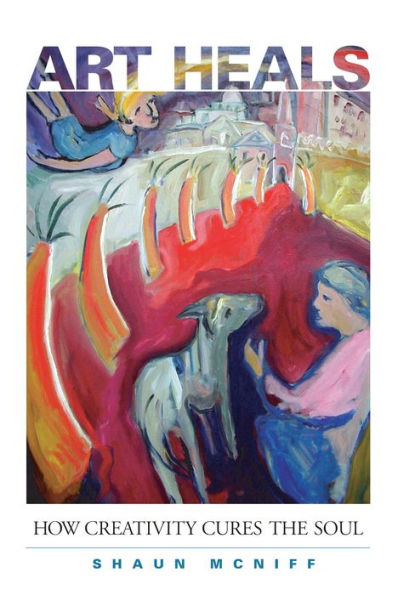

eBook
Related collections and offers
Overview
The field of art therapy is discovering that artistic expression can be a powerful means of personal transformation and emotional and spiritual healing. In this book, Shaun McNiff—a leader in expressive arts therapy for more than three decades—reflects on a wide spectrum of activities aimed at reviving art’s traditional healing function. In chapters ranging from “Liberating Creativity” and “The Practice of Creativity in the Workplace” to “From Shamanism to Art Therapy,” he illuminates some of the most progressive views in the rapidly expanding field of art therapy, including:
• The “practice of imagination” as a powerful force for transformation
• A challenge to literal-minded psychological interpretations of artworks (“black colors indicate depression”) and the principle that even disturbing images have inherent healing properties
• The role of the therapist in promoting an environment conducive to free expression and therapeutic energies
• The healing effects of group work, with people creating alongside one another and interacting in the studio
• “Total expression,” combining arts such as movement, storytelling, and drumming with painting and drawing

Product Details
| ISBN-13: | 9780834827295 |
|---|---|
| Publisher: | Shambhala |
| Publication date: | 11/16/2004 |
| Sold by: | Penguin Random House Publisher Services |
| Format: | eBook |
| Pages: | 256 |
| File size: | 1 MB |
About the Author
Read an Excerpt
From
Chapter 2
Imperfect
Environments
Often the places where we work generate very unattractive auras and disturbing environmental forces. I have constructed many hundreds of nomadic studios throughout my years of practice. I feel like a Bedouin traveler who keeps putting up and taking down his tent. In my travels I don't think I have ever worked in an ideal studio. There is always something that could be better organized in the space. I have contemplated constructing an ideal place, but maybe I should not. The perfect studio could establish an unrealizable standard for others. It may be better for me to keep working with whatever materials I
find in the different places I visit. In this way I demonstrate to others how the studio can be set up anywhere.
Groups repeatedly teach me how to maintain a spiritual presence amidst the din of a work area. If the keeper of the process relaxes, this helps everyone else do the same. The reverse is also painfully true. Everything depends upon our concentration and faith in the process.
Although
I prefer to work in the best space possible, I have repeatedly discovered that the vitality of a studio has more to do with the creative presence generated than the physical features of rooms. I do not mean to discourage architects and interior designers from becoming involved in the art and healing movement, and especially the important work of "universal design" striving to create environments and technologies of communication that accommodate all people irrespective of their physical abilities. We want to have the best spaces possible, yet we must also work with whatever we have, especially when bringing the arts to places with limited financial resources.
Distractions and imperfections may even perversely feed the creative spirit because they are not unlike our often-disheveled lives. There may be a wondrous medicine released when a group fills an unattractive space with imaginative expressions.
When we creatively transform unappealing places, the change of attitude has a corresponding effect on how we perceive ourselves and the world.
Table of Contents
Preface
ix
Acknowledgements
xv
Part
One
INTRODUCTION
1
1
Liberating Creativity 3
Part
Two
ART
IS SOUL'S MEDICINE 9
2
The Creative Space 15
3
Letting Go in a Safe Place 28
4
Embracing Upheaval 31
5
The Early Work, 1970–1974: Anthony, Bernice, and Christopher 34
6
The Art Therapist as Artist 52
7
Aesthetic Meditation 55
Part
Three
OPENING
TO IMAGES AND MEDIA 69
8
The Interpretation of Imagery 75
9
Treating Images as Persons and Dialoguing with Them 82
10
The Challenge of Disturbing Images 96
11
Images as Angels 100
12
Angels of the Wound 112
13
Artistic Auras and Their Medicines 121
14
The Effects of Different Kinds of Art Experiences 137
Part
Four
TOTAL
EXPRESSION 147
15
Pandora's Gifts: Using All of the Arts in Healing 151
16
A Pantheon of Creative Art Therapies 163
17
Working With Everything We Have 168
18
A Review of
Jung on Active Imagination
by Joan Chodorow 171
Part
Five
CONNECTIONS
TO SHAMANISM 181
19
From Shamanism to Art Therapy 183
20
The Shaman as Archetypal Figure 194
21
The Shaman Within 200
Part
Six
REFLECTIONS
ON THE SOURCE 209
22
The Basis of Energy 211
23
The Healing Powers of Imagination 221
24
Surrender to the Rhythm 230
Part
Seven
USING
NEW MEDIA TO EXPAND CREATIVE EXPRESSION 239
25
Video Enactment in the Expressive Therapies 243
26
A Virtual Studio 255
Part
Eight
ART
HEALING IS FOR EVERYONE 263
27
Art Therapy Is a Big Idea 267
28
An Inclusive Vision of Art Therapy: A Spectrum of Partnerships 271
29
The Way of Empathy: The Practice of Creativity in the Workplace 283
30
The Test of Time 290
Sources and Credits
295
Selected
Publications by Shaun McNiff
299
Index
307
